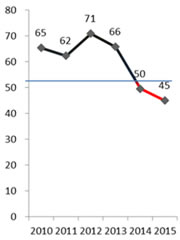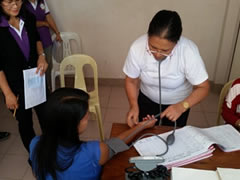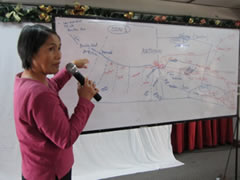- Home
- Technical Cooperation Projects
- Index of Countries
- Asia
- Philippines
- Project for Cordillera-wide Strengthening of the Local Health System for Effective and Efficient Delivery of Maternal and Child Health Services
- Project News
- Maternal Mortality Ratio (MMR) of Cordillera Administrative Region has decreased for three consecutive years.
Project News
2016-05-30
Maternal Mortality Ratio (MMR) of Cordillera Administrative Region has decreased for three consecutive years.
Since 2012, the Project has been providing activities for strengthening the Maternal and Child Health system to deliver effective health services in Cordillera Administrative Region (CAR). To evaluate the outcome of these activities, the Project monitors the region's MMR (Maternal Mortality Ratio) every year. MMR is the ratio of number of maternal deaths per 100,000 live births. The Republic of Philippines has set the National target of MMR at 52 by 2015, however, it was still very high in 2013 (120, WHO data).
To tackle this situation, the Project has been implementing activities, for both health service providers/health officers, and pregnant women and their families who receive the health services. For instance, the project provided medical and non-medical equipment, supported renovation of the local health facilities to be qualified as birthing facilities, provided training for medical workers as well as sending several counterparts to be trained in Japan, and encouraged the pregnant women to avail the antenatal/postpartum care and deliver in any health facility. Additionally, the Project gives emphasis to local government units on creating the effective transportation system for emergency cases. And the counterparts operate the new monitoring system which can support their health workers who are trained in BEmONC (Basic Emergency Obstetric and Newborn Care) to sustain and improve their knowledge and skill continuously.
 Figure: Maternal Mortality Ratio
Figure: Maternal Mortality Ratio
Note: Blue lines in the figures of maternal mortality ratio (MMR) indicates national target of millennium development goals by 2015 (MMR: 52)
(Source: FHSIS report, DOH-CAR)
As a result of these interventions by the Project and Department of Health (DOH)-CAR, MMR in 2015 became 45 and it is below the last year's data (50). Also, the Facility-based Delivery Rate has improved from 78% in 2012 to 92% in 2015.
The Project also conducts yearly Residence-based data gathering such as Facility-based Delivery (FBD) Rate and Philhealth (Philippines' national health insurance) coverage rate of each province, municipality and barangay. For example of FBD rate, in this method, the Project uses the actual number of live births among residents of the municipality as denominator, and number of FBD cases among residents of that municipality. Therefore the result shows the actual situation and the Project can assist municipalities for making more effective interventions. On the other hand, under the FHSIS, delivery cases are usually registered at facilities where those cases occur, which often blurs the true situation of the locality. This strategic type of data gathering has provided the Project a clear picture of accomplishments of all project sites and the region as a whole. Likewise, the Project with full effort of DOH-CAR is going to expand the assistance related to the improving emergency transportation system activity and strengthen the Maternal and Child Health system in a regional setting.
The Project is advancing toward its goals which are to reduce MMR continuously and to sustain those good and effective intervention for the improvement of health status of people in the Project.
 At the BEmONC facility, a member of Monitoring Supportive Supervisory team from DOH-CAR observes the medical capability and skill of a local midwife.
At the BEmONC facility, a member of Monitoring Supportive Supervisory team from DOH-CAR observes the medical capability and skill of a local midwife.
 At the workshop of setting up a referral guideline, all participants join plotting the map which show the positional relation of health facilities and understand their own area's geographical characteristics.
At the workshop of setting up a referral guideline, all participants join plotting the map which show the positional relation of health facilities and understand their own area's geographical characteristics.
- About JICA
- News & Features
- Countries & Regions
- Our Work
- Thematic Issues
- Types of Assistance
- Partnerships with Other Development Partners
- Climate Change / Environmental and Social Considerations
- Evaluations
- Compliance and Anti-corruption
- Science and Technology Cooperation on Global Issues
- Research
- JICA Development Studies Program / JICA Chair
- Support for the Acceptance of Foreign HRs / Multicultural and Inclusive Community
- Publications
- Investor Relations
